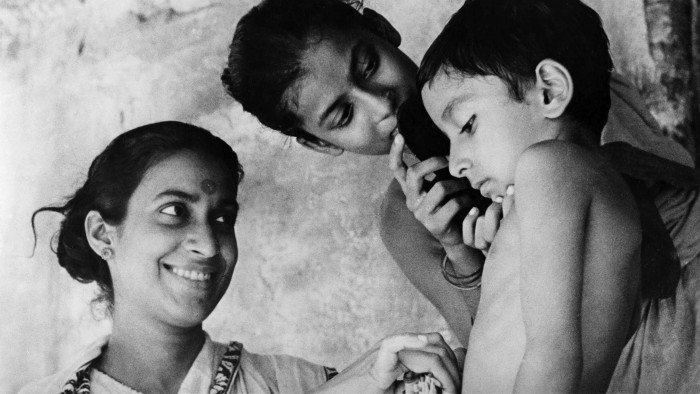Unlock the Editor’s Digest for free
Roula Khalaf, Editor of the FT, selects her favourite stories in this weekly newsletter.
There is a scene in India’s cinematic masterpiece Pather Panchali — or Song of the Little Road, the first film of “The Apu Trilogy” by Satyajit Ray — in which the child protagonist Apu is crouched in a sugar cane field watching a train rumble past. It is a metaphor of the promise of development in a country that was breathing fresh the air of independence from Britain in 1947.
The trilogy, originally released in the 1950s, may seem detached from today’s India — now the world’s fifth-largest economy and home to some of Asia’s richest billionaires. But to many young Indians the film has come as something of an awakening.
Last month, the restored films, which were damaged in a London fire in 1993, were rereleased in a Lutyens’ Delhi cinema. At the end of the trilogy’s first screening there was silence, then sighs, then applause capped by emotional tears.
India has “emerged as one of the fastest-growing large economies in the world”, reads the latest World Bank report. Over the past two decades the economy grew four times in size, helping to lift 106mn people out of poverty, mainly in rural areas, between 2011 and 2021.
Yet the shine is coming off amid a slowdown that “indicates challenges”, the bank says, as India aspires to become a high-income economy by the centenary of its independence. This brings the relevance of Apu — and the ghosts of a “poor India” — back to life in a country where swaths of the population still live hand-to-mouth.
Pather Panchali, which was inspired by the Italian neorealism of Vittorio De Sica’s Ladri di Biciclette, captures the unfiltered daily life of a poor family in rural Bengal, a reality that continues for many in some of parts of India.
“Pather Panchali is a cautionary tale,” said Pronab Sen, an economist from Bengal and former principal economic adviser to India’s planning commission.
While praised for its honesty, the film also faced politicised criticism when it was made. In his memoir, My Years with Apu, Ray said he heard ministers had “taken objection to the film” simply “for being so true a picture of unadulterated poverty”. For years, the legendary filmmaker faced attacks from those who accused him of “exporting poverty”.
Shivendra Singh Dungarpur, an award-winning filmmaker and archivist who heads the Film Heritage Foundation that preserves India’s films, told me that when the film was first released there was uproar. “But since then, we as Indians do realise that it is one of the greatest films ever made and it is still relevant because it is a film about the reality of where India emerges from.”
Apu’s return to India was applauded in New Delhi. There are plans to take it to Kolkata, Ray’s birthplace. This time there has been no public outcry about showcasing poverty.
Surjit Bhalla, an Indian economist — and fan of Ray — who served as executive director for India at the IMF, told me that although measurement of poverty in India has always been a contentious issue, “at the time of the first release” of Pather Panchali, India’s GDP per head was around $80. Last year, it topped almost $3,000.
Bhalla co-authored a paper last month stating that India has already eliminated the most extreme forms of poverty. Only 1 per cent of households fell below the international poverty line of $2.15 a day in 2024.
But while India has made massive economic progress transitioning from a low-income to a middle-income country, it still had 234mn people living in poverty, according to the Global Multidimensional Poverty Index by Oxford university and the UN, as of last year. This makes it the country with the world’s largest number of people living with deprivations.
As national affluence grows, many Indians have become too accustomed to the bling and glitz of recent Bollywood movies. So screening Apu is “very important” to open the eyes of younger generations to poverty, Vasundhara Bhattacharya, a teary-eyed 21-year-old biology student, told me after the film’s ending to a background tune by sitarist Ravi Shankar. The Apu films, she said, are as “relevant as they are timeless”.
